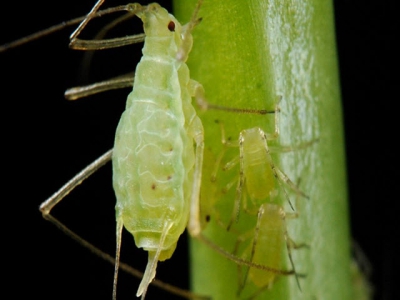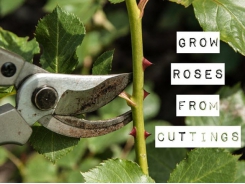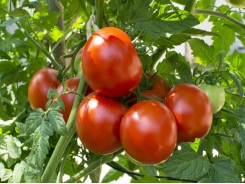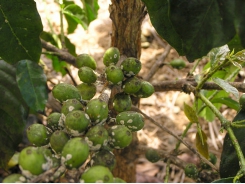Biological Control of Common Greenhouse Pests - Part 1

Some pests in the greenhouse can be controlled by introducing their natural enemies artificially. A range of such biological controls, which may be predatory insects or mites, parasites, bacteria or fungi, are being used increasingly by commercial growers, and some have also been shown to work well in small garden greenhouses. Good examples are the parasitic wasp Encarsia formosa, which controls greenhouse whitefly, and the predatory mite Phytoseiulus persimilis, which controls red spider mite.
You can order these controls through the post, and they come in a form which is easy to distribute around the greenhouse. Provided that they have plenty of food and the right conditions, generally they do not try to ‘escape’, even if you have the doors and ventilators open. More recently introduced biological controls which could be successful in garden greenhouses include nematodes which parasitize vine weevil larvae, and midges which prey on aphids. Details of all these controls are given under the appropriate pest entries. Others, such as the control for scale insect, need higher and more constant temperatures or greater humidity than amateur greenhouses can normally supply, but more may become available in the future.
Using biological controls
ADVANTAGES
- Biological controls are very specific, affecting only the target pest. They are harmless to humans, pets, and beneficial insects, and do not damage plants.
- Ideally, the controls allow a balance to be established so that both control and pest exist at levels which are not damaging. Thus, after the initial introduction you do not have to take any further control measures.
CAUTIONS
- Usually, specific conditions are needed for the controls to work well, eg. the right temperature, humidity, and light levels. Make sure that you can provide these conditions before introducing biological controls.
- They do not work instantly and cannot control epidemics. You must introduce the natural enemy before the problem gets out of hand.
- They can be very sensitive to insecticides — even organic ones. Check that any residues of chemicals you have used in the past will not harm them, and take great care if you use sprays against other pests in the greenhouse after you have introduced a biological control. The fumes from paraffin heaters can harm Encarsia.
- Biological controls can be expensive. One delivery from the supplier is usually more than enough for a small greenhouse, but you cannot store them for future use.
Aphids
Many of the hundreds of aphid species, usually referred to as greenfly or blackfly, feed on plants in greenhouses as well as outdoors. They are mainly green in colour and appear first on shoot tips and the under-sides of young leaves. They feed on plant sap, distorting growth and weakening plants, and they can also carry viral diseases. Another problem is the sticky honeydew which they excrete and upon which sooty moulds grow. These look unsightly and can prevent light getting to the leaves.
Prevention
Look after the plants well: those under stress, particularly through under-watering or incorrect feeding, are more susceptible to attack. Encourage the aphids natural enemies such as hoverflies
(Episyrphus balteatus, Syrphus ribesii, and many other species), lacewings ( Chrysopa spp.) and ladybirds (Coccinella, Propylea, and other species).
Treatment
Examine plants, and even seedlings, regularly Infested leaves and shoots can be picked off large plants, or the aphids squashed by hand. Use insecticidal or soft soap if all else fails.
Biological control
The mite Aphidoletes aphidimyza can be introduced into the greenhouse to help control aphids. Its orange larvae, which can just be seen with the naked eye, feed on any aphids they find before falling to the ground to pupate. They are most active at temperatures of 15-20°C, and are best introduced in late spring or summer If aphid levels are high, then reduce them by spraying first.
Eelworms or nematodes – Nematodae
Several species of these microscopic worm-like creatures attack greenhouse plants. Two of the most common examples are given here:
1. Root knot eelworms – Meloidogyne
These enter into roots and cause swellings or galls. As a result, the plants become stunted and undernourished, and wilt easily. Plants commonly attacked (although not necessarily by the same species of eelworm) include begonias, chrysanthemums, cucumbers, tomatoes, lettuces, and French beans. The eelworms spread through roots, soil, or potting compost to other plants.
Prevention
Do not introduce suspect plants or soil into the greenhouse.
Treatment
Destroy infested plants and potting compost. Change soil in borders and gravel on staging if likely to be affected. Observe strict hygiene with tools, pots, etc. to prevent spread. For tomatoes, you can grow a rootstock resistant to the eelworm, on to which you can graft other varieties.
Biological control
No biological control available as yet.
2. Potato cyst eelworms – Globodera
These enter into the roots of tomatoes, checking growth and reducing yield. The eelworm eggs are contained in spherical brown cysts which you can see with a magnifying glass; these can remain dormant in the soil for up to ten years.
Prevention
Do not introduce suspect plants or soil. Rotate tomato crops in borders, or change the soil regularly, to prevent any cysts present in the soil from building up numbers.
Treatment
Destroy infested plants. Change border soil or grow tomatoes in pots for at least six years.
Biological control
No biological control available as yet.
Glasshouse whitefly – Trialeurodes vaporariorum
These tiny white moth-like insects live on the under-sides of leaves of many greenhouse plants, flying off when disturbed. Both the adults and the immobile white scales, which are their immature form, feed on plant sap. They secrete honeydew upon which unsightly sooty moulds form, and heavy infestations can weaken plants. Whitefly overwinter on plants and weeds in the greenhouse, their eggs surviving even if it is not heated, and they begin to multiply rapidly once temperatures get over 15°C.
Prevention
Examine newly acquired plants thoroughly to avoid bringing in whitefly. Clear weeds and old annual plants out of the greenhouse in autumn to help prevent the pest from overwintering. Treat or destroy any other infested plants.
Treatment
Yellow sticky traps will control small numbers of whitefly and give you an early indication that they are present. For larger numbers, try shaking the plants and using a portable vacuum cleaner to suck up the adults as they fly. As a last resort, spray with insecticidal soap.
Biological control
The parasitic wasp Encarsia formosa lays eggs inside the whitefly scales. These turn black as the eggs develop, and new adult wasps emerge. Introduce the control two to three weeks after you see the first whitefly, but before numbers buildup. Reduce numbers by spraying if necessary. The wasp works best at temperatures of 18-27°C, usually reached in an unheated greenhouse by late spring or early summer, and once established it should keep whitefly below damaging levels for the whole season.
Leaf miners, chrysanthemum – Phytomyza syngenesiae
The leaf miners commonly troublesome in the greenhouse are small flies which lay their eggs inside plant leaves. The larvae which hatch eat out meandering tunnels, spoiling the appearance of the plants. Chrysanthemums and lettuces are amongst the plants commonly affected.
Prevention
The larvae can overwinter on weeds such as sowthistle and groundsel, so make sure that you remove these from the greenhouse and garden if this pest is a problem.
Treatment
Inspect plants regularly and pick off affected leaves as soon as you see them.
Biological control
No biological control available to amateur gardeners as yet.
Related news
Tools

Phối trộn thức ăn chăn nuôi

Pha dung dịch thủy canh

Định mức cho tôm ăn

Phối trộn phân bón NPK

Xác định tỷ lệ tôm sống

Chuyển đổi đơn vị phân bón

Xác định công suất sục khí

Chuyển đổi đơn vị tôm

Tính diện tích nhà kính

Tính thể tích ao



 Pests and Diseases of Tree Fruit - Part…
Pests and Diseases of Tree Fruit - Part…  Plant Pests and Diseases – Biological Control
Plant Pests and Diseases – Biological Control